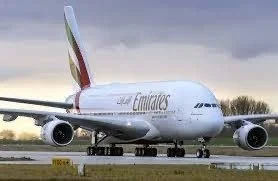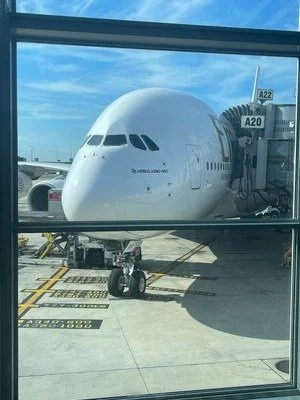Chapter 2: Emirates Airlines and their A-380-800 Aircraft
This is how you get there
02.09.2022 - 02.09.2022 100 °F
Chapter 2: Emirates Airlines/A-380-800 Aircraft
September 2, 2022
At 11:00am, from Washington, Dulles Airport, (7:00pm destination time), we fly to Dubai, a 13-hour experience, aboard an Emirates Airlines super-jumbo A380-800 aircraft. Emirates flies half the 239 behemoth 525-passenger Airbus A-380s in existence. We will arrive in Dubai at 8:00am (tomorrow) local time. That’s 11:00pm in Kansas City.
I list the times because, to limit the effects of jet lag, it is has been our practice to immediately set our clocks to destination time when we first sit down in our airplane seat. That tells our body clocks that, in effect, we are already there. The trick is to tell our bodies—which think it is almost lunch time, that it really is just after dinner time. We will try to go to sleep after about four hours aboard the flight—11:00pm Dubai time. Our bodies will disagree telling us that it is actually only 3:00pm—way too early to go to bed. But, if we can get slumber to come, we can sleep for seven hours, grab a shower and deplane to make our first day a full day. Great plan in theory; very difficult to pull off. Mostly, in fact, on this flight it didn't work.
Why didn’t we choose an American carrier? That's because none fly from the United States, non-stop or otherwise. Since 2015, Emirates has had a monopoly between Dubai and anywhere in the United States. United, Delta and American have correctly accused Emirates—along with two other Middle East carriers—of receiving cash subsidies from their government owners that amount to unfair competition. To be fair, the airline is a subsidiary of The Emirates Group which is a subsidiary of the Investment Corporation of Dubai—of which the government is sole owner.
Our double-decker aircraft requires two boarding gates: A20 for lower floor economy and A22 for upper floor business and first class. On the upper deck, there are 14 first class closed suites. In front, at the top of the staircase, are two large showers—we must book a reservation for a prearranged time during the flight to use them. We opted for 90 minutes before landing. Behind the first class cabin at the front of the aircraft’s upper deck are 76 flat-bed business class seats and a bar/lounge. 399 standard coach seats fill the lower level. On takeoff, our plane weighs about 575 tons; that's 7.5 times heavier than a 737 Max leaving Kansas City (which weighs just under 77 tons). The A-380 is so big that airports around the world had to redesign their gates to handle it—it is 40% bigger than a Boeing 747. This ultimate long-haul, hub-to-hub aircraft would make absolutely no sense for the domestic U.S. market and no U.S. carrier ever bought one. For that reason and many others, the airplane has turned out to be a financial failure for Airbus Industries and production of new A-380s has ceased.
The A-380 was first flown in 2007 at a cost of $428 million each--stripped of fancy amenities; its four Rolls Royce engines cost $15 million each. For reference, the 737 Max lists for $100 million. I’ve flown A-380s several times and will happily testify that they are smoother and quieter than anything else in the air. But Emirates A-380s aren’t the fanciest version of the A-380. Singapore Air offers a “Double Suite” for two in first class; Etihad airlines has something called “The Residence” which consumes 39 square feet of space. While I am anxious to try the Etihad Airlines Apartment, I have no need to fly to their base in Abu Dhabi and, no matter how special is may be, I am completely taken with the Emirates Airlines experience. Full disclosure however: I’ve never flown Emirates Airlines in coach. This is the sexiest, coolest, most fun, most exciting airplane ever--and that's from a guy who flew the supersonic Concorde. Once.
We’re in first class suites 3E and 3F. They are closed-door suites and are adjacent to each other so if we want to spend time together on the flight we can do that by lowering the center privacy wall or go to the First Class/Business Class Bar—a 150-foot stroll through the business class cabin to the rear of the aircraft.[
float=right][/float] One perk flying premium class with Emirates is that a chauffeur-driven car picks you up and delivers you to the airport and at your destination another one takes you to your hotel. For example, we were to be collected from our hotel at 8:30 this morning in an Emirates affiliated limo; no airport Marriott Hotel shuttle for us. But then, the limo provider canceled the trip saying that we were too close to the airport, they don't take trips that short. So, onto the Marriott shuttle we go. I've heard of the trip being too long but not of the trip being too short.
In business only since 1985 (upon being given a gift of two free planes from Pakistan International Airlines to get them started), Emirates Airlines now operates 3,600 flights each week solely on wide body aircraft. Emirates flies only on international itineraries serving 152 airports across 85 countries. (For the record, Pakistan International Airlines today operates a fleet of 29 planes and is banned from flying to the US or the UK because it is alleged that at least a third of all pilot’s licenses issued in Pakistan are not genuine)
Other than the A-380 aircraft, Emirates rounds out their fleet by flying 134 Boeing 777s which can hold nearly 400 passengers.
(Also Emirati government owned, Flydubai Airlines is a low-cost carrier specializing in shorter haul flights across the Middle East, Africa, Europe and South Asia. I’ve never flown them.)
Brit Sir Timothy Charles Clark has led Emirates Airlines for almost 20 years. He is one of 45,843 employees who hail from 160 different countries. A perk of working as a flight attendant for Emirates and Sir Tim is that you get free housing in Dubai and “super discounted” tickets, comprehensive health care, paid maternity and sick leave and a 30-day vacation annually. However, you are only paid $1,160 a month to start. One report says Emirates is currently operating a policy whereby female cabin crew who become pregnant in the first three years have to leave. Interestingly, only 3% of Emirates Airlines employees are Emirati and very few of those are flight attendants. “Emiratis do not want to do jobs in the low-ranking grades,” said Abdul Aziz Ali, Emirates’ executive vice-president of human resources.
Emirates has never had an accident resulting in a fatality.
Here is an Emirates Airlines television commercial—in my opinion the most amazing airline television commercial ever:









